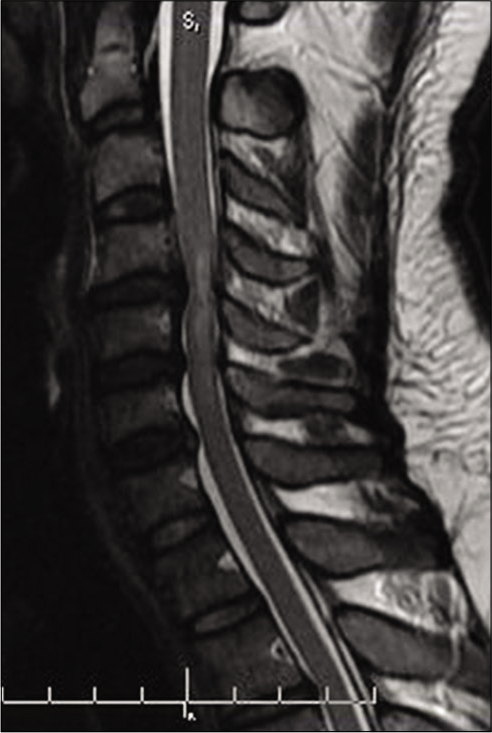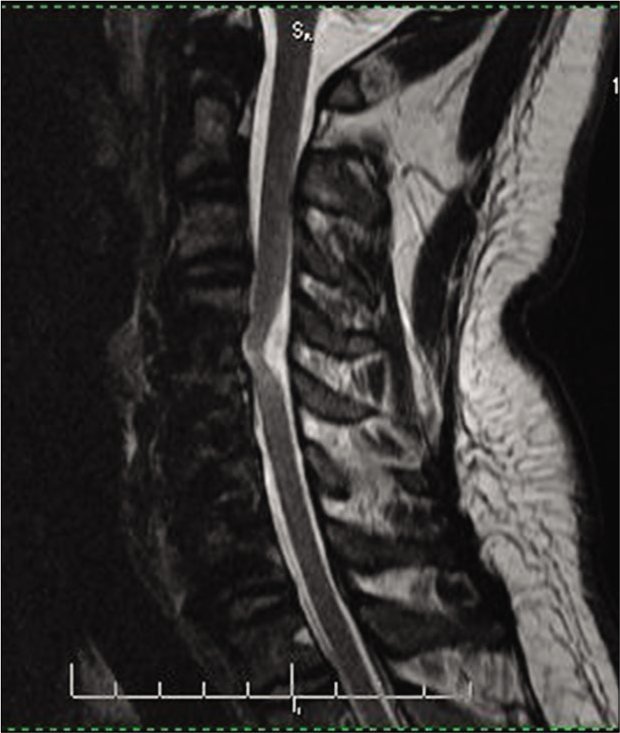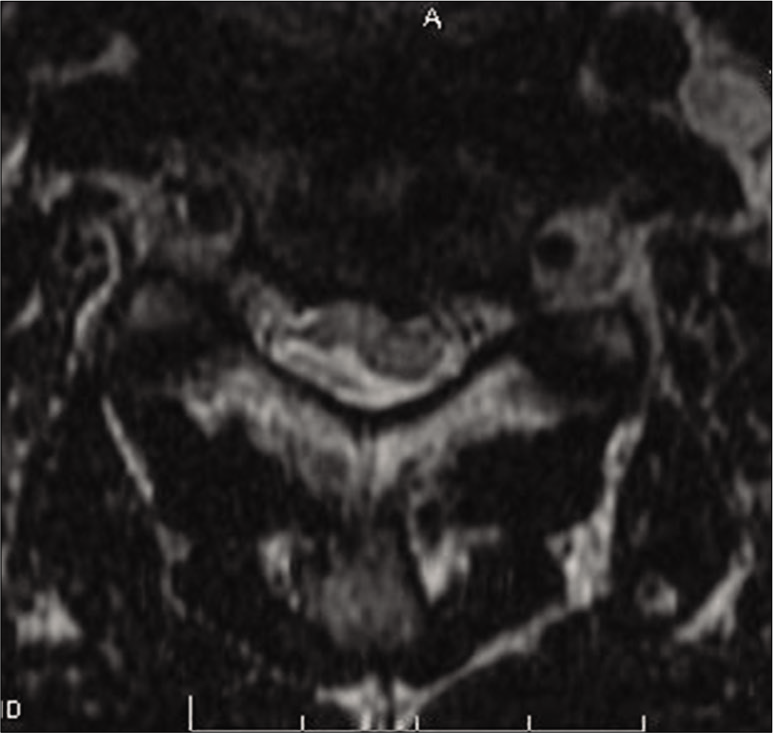- Department of Neurosurgery, Salford Royal Foundation Trust, Salford Royal Foundation Trust, Stott Lane Manchester, Greater Manchester, United Kingdom.
DOI:10.25259/SNI_508_2020
Copyright: © 2020 Surgical Neurology International This is an open-access article distributed under the terms of the Creative Commons Attribution-Non Commercial-Share Alike 4.0 License, which allows others to remix, tweak, and build upon the work non-commercially, as long as the author is credited and the new creations are licensed under the identical terms.How to cite this article: Siddharth Sinha, K. Joshi George. Spinal cord herniation following multilevel anterior cervical discectomy and fusion: A case report and literature review. 08-Oct-2020;11:327
How to cite this URL: Siddharth Sinha, K. Joshi George. Spinal cord herniation following multilevel anterior cervical discectomy and fusion: A case report and literature review. 08-Oct-2020;11:327. Available from: https://surgicalneurologyint.com/surgicalint-articles/10314/
Abstract
Background: Anterior cervical discectomy and fusion (ACDF) is one of the most commonly performed spinal operations. Spinal cord herniation following these procedures is rare, more typically being described as occurring posteriorly rather than following anterior corpectomy and fusion (e.g., reported in four corpectomy cases). Here, we describe a case in which spinal cord herniation was attributed to a three-level ACDF.
Case Description: A 31-year-old male initially presented with a 1 year’s duration of increasing myelopathy attributed to MR documented three-level disc disease (C4-C7). He successfully underwent a three-level ACDF without complications/durotomy. One year later, he again presented, with myelopathy (i.e., recurrent neck pain and stiffness) newly attributed to MR documented anterolateral C4-C5 cord herniation. As he declined further surgery, he was treated medically (e.g., utilizing analgesia and physiotherapy) and was no worse 6 months later.
Conclusion: The occurrence of spinal cord herniation through a prior ACDF defect must be considered when patients present with recurrent myelopathy following previous ACDF surgery.
Keywords: Anterior cervical discectomy and fusion, Herniation, Myelopathy
INTRODUCTION
Anterior cervical discectomy and fusion (ACDF) is one of the most common spinal operations performed in the U.S. and worldwide to treat herniated discs, cervical spondylosis, fractures, and neoplasms.[
There have been just four known cases of anterior spinal cord herniation following multilevel anterior corpectomy fusion cases.[
CASE DESCRIPTION
A 31-year-old male originally presented with a 1-year history of progressive myelopathy (e.g., four-limb hyperreflexia). The MR revealed three-level disc disease (e.g., C4/C5, C5- C6 and C6/C7) resulting in spinal canal stenosis and cord compression; the preoperative MR showed a high cord signal on the T2-weighted study at the C4/5 level [
One year later, he developed a recurrent and progressive myelopathy; it was attributed to MR documented anterolateral spinal cord herniation on the right at the C4/5 level [
DISCUSSION
More than a hundred cases of spinal cord herniation have been described in literature. The vast majority, however, occur in the thoracic spine; they are considered idiopathic and/or attributed to congenital causes and/or trauma. Interestingly, 2/3 of cases occur at the level of a disc herniation.[
Incidence of CSF leaks after anterior cervical surgery and frequency of associated myelomeningoceles
The vast majority of small CSF leaks following cervical surgery (1%) are clinically insignificant and had no sequelae up to 5-year postoperatively.[
Prior reports of anterior spinal cord herniation
The etiology of spinal cord herniation following anterior cervical surgery is not well delineated. Cases of anterior spinal cord herniation following anterior cervical corpectomy and fusion have been described. Finneran et al. described anterior cord herniation occurring 17 years after a single-level C5 corpectomy in the absence of an obvious original intraoperative dural defect. The authors attributed the cord herniation to a thinning/ resorption of the corpectomy graft and to dural thinning/ attenuation to adhesions of the spinal cord, with CSF pulsation/hydrostatic factors contributing to spinal cord herniation.[
Two cases of posterior cervical cord herniation following laminectomies
Two cases of posterior cervical cord herniation following laminectomies were identified. One case involved posterior spinal cord herniation into a pseudomeningocele occurring 14 years after a laminectomy performed for excision of an intradural extramedullary neurinoma.[
CONCLUSION
Anterior spinal cord herniation may occur following an ACDF and be attributed either to an atretic dura at the level of preoperative maximal compression or to an unobserved intraoperative durotomy.
Declaration of patient consent
Patient’s consent not required as patients identity is not disclosed or compromised.
Financial support and sponsorship
Nil.
Conflicts of interest
There are no conflicts of interest.
References
1. Brus-Ramer M, Dillon WP. Idiopathic thoracic spinal cord herniation: Retrospective analysis supporting a mechanism of diskogenic dural injury and subsequent tamponade. Am J Neuroradiol. 2012. 33: 52-6
2. Cloward RB. The anterior approach for removal of ruptured cervical disks. J Neurosurg. 1958. 15: 602-17
3. Cobb C, Ehni G. Herniation of the spinal cord into an iatrogenic meningocele. Case report. J Neurosurg. 1973. 39: 533-6
4. Epstein NE. A review of complication rates for anterior cervical diskectomy and fusion (ACDF). Surg Neurol Int. 2019. 10: 100
5. Finneran MM, Schaible K. Ventral herniation of the cervical cord after single-level corpectomy. World Neurosurg. 2020. 136: 12-6
6. Guerin P, El Fegoun AB, Obeid I, Gille O, Lelong L, Luc S. Incidental durotomy during spine surgery: Incidence, management and complications. A retrospective review. Injury. 2012. 43: 397-401
7. Hannallah D, Lee J, Khan M, Donaldson WF, Kang JD. Cerebrospinal fluid leaks following cervical spine surgery. J Bone Joint Surg Am. 2008. 90: 1101-5
8. Schaberg MR, Altman JI, Shapshay SM, Woo P. Cerebrospinal fluid leak after anterior cervical disc fusion: An unusual cause of dysphagia and neck mass. Laryngoscope. 2007. 117: 1899-1901
9. Smith GW, Robinson RA. The treatment of certain cervical-spine disorders by anterior removal of the intervertebral disc and interbody fusion. J Bone Joint Surg Am. 1958. 40: 607-24
10. Xu R, Zhu Y, Ma WH, Wu J. The prevention and treatment of cerebrospinal fluid leakage following cervical spine surgery. Zhongguo Gu Shang. 2010. 23: 20-2








